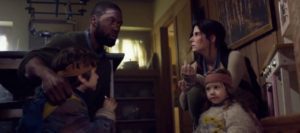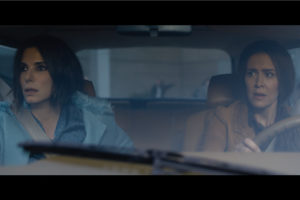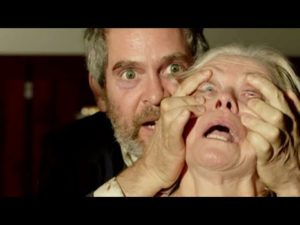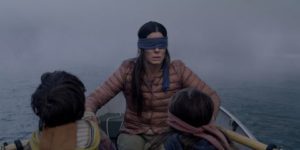Bird Box, the newest Sandra Bullock film exclusively on Netflix, is almost a good film. Almost. It’s so close. There’s a ton of promise, a strong list of actors and actresses, an interesting premise – it has a lot going for it. And it’s almost, almost a good film. But, it never quite gets there.
Let me be clear as I’m writing this: Bird Box is not a bad film, per se. Internet frenzies being what they are, I’ve seen a lot of people bashing this movie, and I don’t think that’s necessarily warranted. It has many good elements going for it, and it’s, by far, not the worst film I’ve seen, even in 2018. But, there is plenty to be talked about and critiqued.
WARNING: MAJOR SPOILERS for Bird Box! If you haven’t watched it yet, go see it first and then come back.
In an attempt to add to the public discourse that seems to be currently sweeping the internet (even garnering a meme or two), we’re going to talk about the bad and the good of Bird Box, and even discuss a few ways that things could have been improved upon along the way.
This is also a good time to note that the film was based on a book of the same name by Josh Malerman, so as such, any elements discussed here are specifically pertaining to the film version. I may occasionally bring up the book as a means to discuss the movie, but the book itself is its own thing.
With that out of the way, let’s get into a discussion on why Bird Box is almost a good film.
I. The Good Parts
Let’s start out this conversation by starting with what I believe to be the two strongest elements of the film: the premise and the acting (for the most part).
For the uninitiated, Bird Box revolves around Malorie Hayes (Bullock), a young woman who finds herself in the middle of a nightmare scenario where mysterious, unseen monsters are causing people to kill themselves upon making eye contact with them. However, as long as you don’t look directly at the beings, then you’re safe. Apparently, the creatures also can’t go indoors, so as long as you’re in a house, market, or an aviary in the middle of the woods, then you’re good to go. Basically, it’s a blind version of A Quiet Place meets The Happening, except with 100% less Marky Mark.
This premise itself is definitely interesting enough to pique one’s interest, especially being a Netflix exclusive film, which implies a certain creative freedom that other major studio productions wouldn’t necessarily provide. Additionally, the idea of a formless creature causing immediate death via suicide elicits a certain morbid curiosity – what could these creatures be doing to have such an effect on people? It’s an original twist on the hunter/prey scenario that we’ve seen with other post-apocalyptic films, like zombies or crazy scythe monsters trying to murder John Krasinski.
This movie doesn’t have John Krasinski in any form, but it does have Sandra Bullock, John Malkovich (Being John Malkovich 1999), Trevante Rhodes (The Predator 2018), and Sarah Paulson (American Horror Story, Glass 2019), as well as trendy names like Danielle Macdonald (Dumplin’ 2018) and, uh, Machine Gun Kelly. Sure, why not? That cast alone sounds like something I’d want to see – all of them are talented in their own rights, even if one of them sort of lost a rap beef with Eminem. (It’s okay MGK, I forgive you, even if Orlando probably never will.)
But, even with good acting and a good premise, it’s all about execution. And, tying in with the subject of actors, we have our first not-so-good part of Bird Box…

II. The Characters
Even if you line your cast with big names and talent, that won’t mean a thing if your film’s characters are written poorly. Have we learned nothing from Prince of Persia? Jake Gyllenhaal AND Ben Kingsley in the same movie?! You can’t do my boys dirty like that!
Malorie is a suitable enough character surrogate, and Sandra Bullock is a fantastic actress. But her character lacks any real conviction outside of the motherly role that is thrust upon her (more on that later), which already relies on her being a blank slate that the film can throw action set pieces at.
However, this is nothing compared to the one-note, predictable, just plain bland cast of characters that she meets at Douglas’ (Malkovich) house. You can practically call them all out based on their first lines of dialogue. Hey look, it’s the pessimistic asshole! Hey look, it’s the naive nice guy! Hey look, it’s the love interest! Hey look, it’s the elderly character that will probably get a good shot in later but inevitably won’t be important enough to keep around in the long run! Check, check and check!
Do these characters get any kind of development that would make us care about them? Hardly. When Felix (MGK) and Lucy (Rosa Salazar: The Maze Runner: The Scorch Trials 2015) steal the car to abandon the crew, what’s their motivation? Did they dislike the group? Do they deem the situation as too dangerous? Did they take the “get a room” line to heart? Do we care?
More egregious than character motivations are the numerous wack decision-making moments in Bird Box. One major moment that legitimately took me out of the film was when Olympia (Macdonald) casually lets a complete rando named Gary (Tom Hollander: Pride & Prejudice 2005) into the house, offscreen, and everyone defends her decision, despite not even bothering to check the dude’s bag. What?!? Why would any of the characters do that, and why would Olympia be so easily forgiven moments later? That’s besides the fact that, despite this decision leading to the deaths of almost every character in the house, Malorie ends up NAMING ONE OF HER CHILDREN AFTER HER?! I don’t care if Olympia was the birth-mother, it’s ridiculous (and honestly a little insulting) to name your child after the doofus who got your whole community murdered by a possessed sketch artist.

This is just one example of the many odd and out-of-logic choices made throughout the film that seem to be made only to drive the plot forward. While we’re on the subject of Gary…
III. The Monsters (And The Infected)
Let me be forthcoming here: the idea of the creatures in Bird Box essentially being Boggarts from Harry Potter is a pretty cool idea. The fact that what you perceive the creatures as is a manifestation of your innermost demons and personal fears has a lot of potential, and you could get creative with what people could see, and how they could defend themselves against such a monster. I didn’t have a problem with that, or how the creatures were portrayed (even if the jokes of, “It’s just The Happening, Part 2,” are definitely warranted in places. Leaves = danger!)
The issue I have here is the idea that people can get “infected” by the creatures – that they can be corrupted and affected by the monsters, but not immediately kill themselves. This presents an immediate contradiction to the sense of urgency that we’ve seen up until now, and just serves to overly complicate the concept of the creatures themselves.
The result of the infection, as we see in the film, is an immediate turn to psychosis, and the urge to kill either via forcing others to look at the creatures or just by straight-up murderin’ their ass by any means possible. It’s a bit like the cell phone signal in Stephen King’s Cell. This concept would honestly be fine – despite my personal bias – if there were better rules in place to determine who gets infected, how long the infection lasts, how immediately it takes hold, what the exact effects are on the person’s mental state, etc. It doesn’t have to be exposition-dumped, but the audience would need to see examples of how the creatures – and their effects on people – work.
Throughout the film, we see a number of different manifestations of the infected, and all of them seem perfectly tailored to specific dramatic moments in the film, as opposed to being realistically consistent. The first time we see an infected is on the river with Malorie and the kids: a random dude who attempts to lure the gang off course and kill them. An isolated incident, done and done. Fine. The next time we see one is in the grocery store, when the group (earlier in the timeline) are almost convinced to let them inside. So far, all is consistent with the infected: both male, both middle-aged, both presented already in the midst of their madness. Fine.
But then, we get Gary. And Gary seems to have a set of rules entirely his own.
First off, when we first meet him, he’s completely cognizant, even conversational and empathetic, for the first day (Week? Month? Hour? We really don’t know) that he’s at the house, before he suddenly goes AWOL. Until then, he had no killing urges of any kind.
Secondly, it’s not seeing the things that triggers him to become an infected, but only after having some chill time looking at his creepy drawings and listening to classical music. Huh? How does that make sense? Did he see one of the creatures earlier? Does infection happen over time? We saw the creatures kill someone through a TV monitor – can they also affect their targets through drawings? How long had Gary been making these drawings? How long has he been infected? None of those questions matter, because after getting out one more drawing, Gary’s eyes go wonky, and then he starts his murder spree.

It’s okay in a horror film to not necessarily answer all the viewer’s questions about everything. In fact, some of the best films are better for not answering all their questions outright (such as the excellent Hereditary that came out earlier this year). But if you’re going to go that route, then you at least have to set some consistent ground rules. For example, how is it determined who gets infected, and who dies from exposure to the creatures? How long does it take for infection to take hold? Can infection be hidden, like Gary, or is it always sudden and aggressive, like the earlier two examples?
None of this is even counting the final example, when Tom (Rhodes), who becomes infected by going outside and seeing one of the creatures, manages to still kill the last baddie before he shoots himself. But… how? What makes him able to delay his suicide? Is it just pure force of will? Can some people prolong their deaths via distractions? There’s already so much going on that this just seems like an extra way to bend the rules of the creatures, just to get some extra emotional pull out of the scene.
Call it nitpicking if you will, but in the context of the film, it just seems like the plot needed a way to get Malorie on the way to her present day timeline… it needed a way to kill off all the characters so she would be forced out onto the road. Surely there’s other ways that you could have done that with what you had – the creatures themselves are already so open-ended that you can find a million ways to get that going without having to introduce complicated rules for infected people. Or, daresay, not even introduce infected people at all.
In almost every other post-apocalyptic scenario portrayed in film – not just this one – there’s always scavengers and people just looking to take advantage of others on the road. Why not just have someone in the party betray the others due to a purely selfish reason, instead of this whole “Oh damn! I guess he was infected the whole time!” excuse? Not only would it be more believable, but you wouldn’t have to explain anything. We get it, people can be assholes. In fact, this can be foreshadowed with Felix and Lucy stealing the car. See? Solid theme idea, right there!
And hey, speaking of which…

IV. The Themes
From the final moment of the film (and a lot of heavy-handed moments leading up to it), the theme of Bird Box seems to be reluctant motherhood. That’s not an assumption, either – it’s a quote from Susanne Bier, the director. And hey, that’s not a bad theme to have. A lot of other films, especially horror (Aliens and Mama, anyone?) uses the concept of newfound motherhood to instill a sense of urgency, and also purpose, into a protagonist who may be otherwise unsure of their place in the world.
But, in the case of Bird Box, at what cost does motherhood come to Malorie?
We see at the beginning of the movie that she has a budding career as a painter. She says herself that she’s sold works in the past, and that she’s working on a new one even as the exposition machine – AKA her sister, Jess – sets up the story. But, through clearly unplanned circumstances, Malorie has become pregnant and seems to be bringing the baby to term. That’s all well and good. It adds tension to the story.
But, as the film shows us, Malorie has to give up her dreams of being an artist to survive, and thus, to help her child (later children) survive. Too bad on being an artist, Malorie. It’s a new world now. There’s no time for art, only survival. In a story where our main character has two kids that she can’t even give names to until they’re all nearly murdered by nightmare demons, you want me to believe that this ending is what’s best for her? That this is even what she wants?
To bring this theme home, what’re the odds that her damn OBGYN is one of the only people to not only survive the chaos, but also to somehow make it, on her own, to the sanctuary at the end of the film? And then the first words out of her mouth are essentially, “Wow, guess you’re a parent now, huh? How’s that goin’ for ya?” Nothing about Malorie’s personal health, or her sanity, or how she made it all the way over on her own… it’s all about the kids, now. Because that’s what Malorie’s life has become in this new world of motherhood, one that she didn’t even ask for, one that has seemingly stripped her of her own agency and dreams, and dropped her into a hellscape where any existence other than survival – and the rearing of said children – is equatable to death.
A little heavy, you ask? Yeah, maybe. This is only one interpretation, after all. But with the theme of motherhood in this film, accidentally or otherwise, comes the question of what happens to the creative self when children are introduced into one’s world. And, judging from the interactions of the characters and the paths they took to get where they end up, the results are not hopeful for any kind of inventive existence.
V. Conclusion
Bird Box is a film with an interesting concept, an amazing cast, and fairly decent direction that is bogged down by flat characterization, confusing and convenient contrivances of plot, unclear rules regarding the monsters and their effect on people, and an ending that leaves our main heroine in an unexpected (and most likely unintended) existential crisis of self. With a few minor tweaks to certain things, this could have been a really interesting and gripping film. Unfortunately, this film falls into the void of mediocrity, where, similar to being blinded, no one light from it can truly shine. And that’s the worst fate of all.
 PopHorror Let's Get Scared
PopHorror Let's Get Scared




